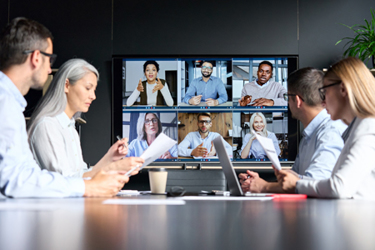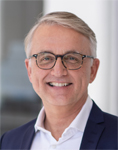Optimized Collaborations From R&D To Manufacturing

By Louis Garguilo, Chief Editor, Outsourced Pharma

Paul Peter Tak, MD, PhD, has been a Professor of Medicine, founded and chaired organizations and companies, sat on boards, led start-up biopharmas, and spent years as Chief Immunology Officer and Global Development Leader at GSK, all before becoming CEO of Candel Therapeutics in September 2020.
He’s formed scientific liaisons and outsourcing partnerships at every phase of drug discovery, development, and manufacturing.
“For my current role,” he says, “I try to pick the best element from what I've learned in past environments.”
Here’s one of those elements for research, development, and manufacturing.
Friendly Scientists

How do you work optimally with external scientists?
Today Tak leads an organization “fit-for-purpose ” with some 65 employees, yet begins his answer by imagining the leader at a Big Pharma, with perhaps 10,000 scientists.
Although that sounds like massive scientific firepower, he says even here “remember most of the scientists in the world do not work for you. You want to think through how to collaborate with more of those external professionals as well.”
You can start with “traditional” consultants and scientific advisory boards, but there are other avenues.
As an example, at GSK, Tak created a partnership with the University of Cambridge, taking advantage of location: GSK’s R&D hub in Stevenage, U.K., is about 45 minutes away.
“I personally drove the collaboration with Cambridge,” he says. “It resulted in more than 30 collaborations between scientists from GSK and Cambridge University.”
The key to success was creating a mutual understanding of what could be achieved together.
“The scientists in academia are not better or worse than in the industry, nor the other way around,” he says. “They’re just working in different environments with a slightly different remit.”
Therefore, his first step was “personalize it, so people get to know each other, and work to the point they almost forget which side they are on – become one functional team.”
This, acknowledges Tak, takes time, but he’s learned it’s critical and ,“applicable in any stage of ‘outsourcing.’ Build trust – defined as mutual respect and understanding of what everybody brings to the table.”
Another example from his GSK years of accessing “the external environment in an innovative way” is the creation of ‘The Immunology Network.’
“I'm an immunologist; I believe there's hardly a field in medicine or any therapy not touched by the immune system, for example autoimmunity, immuno-oncology, or vaccination,” Tak explains. (He believes “the next revolution” will be in neuro-immunology.)
“I consider this field a scientific platform. While I’m specialized in immunology, I realize at any time point there’s more I don’t know than I do. Therefore, it’s critical to create collective intelligence, and access the brightest minds in-house and externally. This is what we created in The Immunology Network.
A pillar of that was the ‘External Immunology Board,’ a global think tank of professors who share the language of immunology, but have “overlappings and differences in expertise.”
“Discoveries are often made at these interfaces,” he says.
Now at Candel, Tak has created a Research Advisory Board (separate from his advisory board and consultants).
“I want independent views from the best experts,” he says. One board member is Jim Allison, the 2018 Nobel Prize laureate, “basically the founder of the field of immuno-oncology.” Others are experts focused on pancreatic, prostate, brain, and lung cancers – all indications Candel is pursuing.
“I always use the same principles: Bring the best people together, have the right debate, and focus on the best science. Ultimately, this leads to value for patients and shareholders."
Differently Developed
Decisions on the development front, says Tak, stem from this key question:
What are you going to do in-house, and what externally?
After the above, his answer is surprising.
“Currently, we do most of the clinical development ourselves,” he says. “It’s why we have succeeded at being super-cost effective. At the moment, we are doing six clinical trials, and this is going very well.”
But what of the importance he places on externalization?
“It's a good question,” he responds. “Things evolve over time. This is what I inherited when I joined the organization. We have talented people and they’ve done a great job.”
“By the end this year,” he continues, “we expect to do up to eight clinical trials in multiple solid tumors, with two different investigational medicines. With this in mind, we will increasingly focus on externalization.”
Tak believes as the organization grows, it should have the ability to “switch things on and off.”
“You won’t need the same capacity all the time. It's not the most efficient development model moving forward.” He’s brought in senior leaders who we will “have the flexibility to switch strategies between internal and external, and oversee collaborations as we expand.”
He adds:
“It may be a bit more expensive if you outsource, but you don't end up with a huge, fixed headcount, and a fixed cost for the company while you grow. The question is: ‘How can you make this successful as a hybrid strategy?’
“Again, you need to personalize relationships with external partners. One aspect is not to put too many layers of oversight on top of the external partner to ensure they are empowered and accountable.
“Get the right oversight, create teams that almost forget they work for a service provider or Candel. Have one mission: develop these medicines so they get to patients and create value.”
Build Manufacturing Control
Before Tak joined Candel, the company outsourced everything in terms of manufacturing the needed ‘viral gene constructs.’”
Impressively, Candel has already acquired all the clinical material needed for each of its trials this year, including an ongoing, phase three prostate cancer clinical trial, and those in non-small lung cancer, pancreatic cancer, and high-grade glioma.
From this point on, though, Tak craves more “control.”
“We are building manufacturing capability to do analytics and produce commercial batches ourselves,” he explains.
“We may end up with a hybrid model here as well. I want to be efficient, and have the capability to switch things on-and-off as needed. We don’t want to be fully dependent on external parties.”
What we’ll take up in our next segment with Tak, is how Candel’s in-house vs. CDMO manufacturing strategy and formal risk analysis – still works in progress –include input from those external partners.
